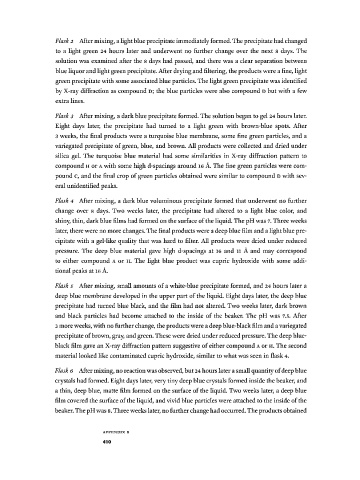Page 427 - Copper and Bronze in Art: Corrosion, Colorants, Getty Museum Conservation, By David Scott
P. 427
Flask 2 After mixing, a light blue precipitate immediately formed. The precipitate had changed
to a light green 24 hours later and underwent no further change over the next 8 days. The
solution was examined after the 8 days had passed, and there was a clear separation between
blue liquor and light green precipitate. After drying and filtering, the products were a fine, light
green precipitate with some associated blue particles. The light green precipitate was identified
by X-ray diffraction as compound D; the blue particles were also compound D but with a few
extra lines.
Flask 3 After mixing, a dark blue precipitate formed. The solution began to gel 24 hours later.
Eight days later, the precipitate had turned to a light green with brown-blue spots. After
3 weeks, the final products were a turquoise blue membrane, some fine green particles, and a
variegated precipitate of green, blue, and brown. All products were collected and dried under
silica gel. The turquoise blue material had some similarities in X-ray diffraction pattern to
compound H or A with some high d-spacings around 16 Â. The fine green particles were com
pound c, and the final crop of green particles obtained were similar to compound D with sev
eral unidentified peaks.
Flask 4 After mixing, a dark blue voluminous precipitate formed that underwent no further
change over 8 days. Two weeks later, the precipitate had altered to a light blue color, and
shiny, thin, dark blue films had formed on the surface of the liquid. The pH was 7. Three weeks
later, there were no more changes. The final products were a deep blue film and a light blue pre
cipitate with a gel-like quality that was hard to filter. All products were dried under reduced
pressure. The deep blue material gave high d-spacings at 16 and i l  and may correspond
to either compound A or H. The light blue product was cupric hydroxide with some addi
tional peaks at 16 Â.
Flask 5 After mixing, small amounts of a white-blue precipitate formed, and 24 hours later a
deep blue membrane developed in the upper part of the liquid. Eight days later, the deep blue
precipitate had turned blue black, and the film had not altered. Two weeks later, dark brown
and black particles had become attached to the inside of the beaker. The pH was 7.5. After
3 more weeks, with no further change, the products were a deep blue-black film and a variegated
precipitate of brown, gray, and green. These were dried under reduced pressure. The deep blue-
black film gave an X-ray diffraction pattern suggestive of either compound A or H. The second
material looked like contaminated cupric hydroxide, similar to what was seen in flask 4.
Flask 6 After mixing, no reaction was observed, but 24 hours later a small quantity of deep blue
crystals had formed. Eight days later, very tiny deep blue crystals formed inside the beaker, and
a thin, deep blue, matte film formed on the surface of the liquid. Two weeks later, a deep blue
film covered the surface of the liquid, and vivid blue particles were attached to the inside of the
beaker. The pH was 8. Three weeks later, no further change had occurred. The products obtained
A P P E N D I X Β
410

